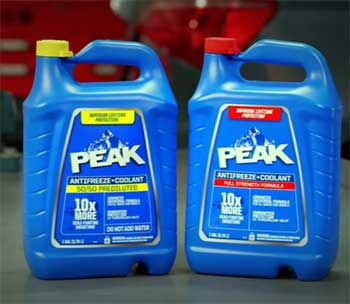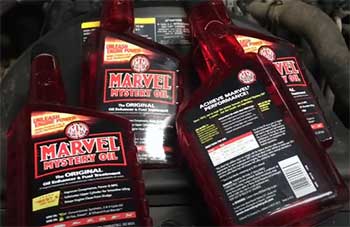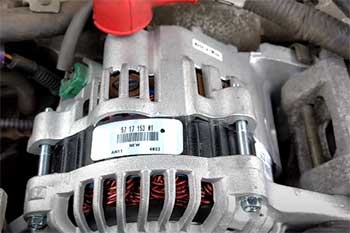I’ve spent years tinkering with cars, from my old Ford pickup to my wife’s Honda sedan, and one thing I’ve learned is that choosing the right coolant isn’t just about grabbing a jug off the shelf.
It’s about keeping your engine happy, avoiding costly repairs, and ensuring your car doesn’t overheat in the middle of a summer road trip. In this article, I’m comparing two heavyweights in the coolant world—PEAK and Prestone.
I’ll break down their features, weigh their pros and cons, and help you decide which one’s best for your ride.
A Brief Comparison Table
| Feature | PEAK Coolant | Prestone Coolant |
| Type | OAT, pHOAT, Si-OAT options | OAT, HOAT, universal options |
| Compatibility | Vehicle-specific and universal formulas | Claims universal compatibility with any coolant |
| Longevity | Up to 10 years/150,000–300,000 miles | Up to 10 years/300,000 miles |
| Corrosion Protection | Advanced OAT, phosphate-free options | Patented Cor-Guard technology |
| Price (1 gal) | $10–$20 (varies by formula) | $12–$25 (varies by formula) |
| Availability | Widely available, slightly less common | Ubiquitous at auto stores |
| Best For | Asian vehicles, some Fords | Broad compatibility, all makes/models |
Why Coolant Matters To Me (And You)

Let’s get real: coolant isn’t the most exciting part of car maintenance.
It’s not like picking out new rims or installing a roaring exhaust.
But when your engine starts steaming on a hot July day, you’ll wish you’d paid more attention to that jug of colored liquid under your hood.
Coolant, or antifreeze, does three critical jobs: it prevents your engine from freezing in winter, overheating in summer, and corroding over time.
Without it, your radiator, water pump, and hoses could turn into a rusty, clogged mess, costing you hundreds—or thousands—in repairs.
I learned this the hard way years ago when I neglected a coolant flush on my old Chevy. The radiator clogged, the temp gauge spiked, and I was stranded on the side of the road with a $1,200 repair bill.
Since then, I’ve been obsessive about choosing the right coolant, and PEAK and Prestone are two brands I keep coming back to. They’re both trusted, widely available, and have a reputation for keeping engines cool and corrosion-free. But they’re not identical, and picking the wrong one could mean the difference between a smooth-running car and a headache.
Understanding Coolant Types: A Quick Primer
Before we get into the nitty-gritty of PEAK and Prestone, let’s talk about coolant types. This stuff can get confusing, especially with all the acronyms floating around: OAT, HOAT, pHOAT, Si-OAT, IAT. Here’s the deal in plain English:
- IAT (Inorganic Additive Technology): Old-school coolant, typically green, used in older vehicles (pre-1990s). It’s silicate-heavy and needs replacing every 2–3 years.
- OAT (Organic Acid Technology): Modern coolant, often orange or red, with longer life (5–10 years). It’s silicate-free, great for aluminum engines.
- HOAT (Hybrid OAT): A mix of IAT and OAT, often yellow or turquoise, balancing corrosion protection and longevity.
- pHOAT (Phosphated HOAT): Common in Asian vehicles (Toyota, Honda), silicate-free, phosphate-based.
- Si-OAT (Silicated OAT): Used in European vehicles (VW, Audi), silicate-based for specific engine designs.
PEAK and Prestone both offer a range of these formulas, but their approaches differ. PEAK leans toward vehicle-specific coolants, while Prestone pushes its “All Makes/All Models” universal formula hard. Let’s break down what each brand brings to the table.
PEAK Coolant: My Take
PEAK has been around for decades, and I’ve used their products in everything from my Toyota Corolla to my buddy’s Dodge truck. Their lineup includes several coolants, but the most popular are PEAK Global Lifetime, PEAK OET (Original Equipment Technology), and PEAK 10X. Here’s what stands out to me.
Key Features of PEAK Coolant
- Variety of Formulas: PEAK offers OAT, pHOAT, and Si-OAT coolants tailored to specific vehicles. Their PEAK OET Asian Vehicle coolant, for instance, is designed for Toyota, Honda, and Nissan, while their North American formula works well for GM and Ford.
- Longevity: PEAK’s Global Lifetime and 10X coolants boast up to 10 years or 150,000–300,000 miles of service life, depending on the formula and whether you flush the system properly.
- Phosphate-Free Options: Many PEAK coolants, like the OET Asian, are phosphate-free, which is a big deal for Japanese vehicles that can suffer from phosphate-related corrosion.
- Affordability: PEAK tends to be slightly cheaper than Prestone, with a gallon of concentrate often costing $10–$15 at stores like AutoZone or Walmart.
Pros of PEAK Coolant

- Vehicle-Specific Precision: I love that PEAK offers coolants tailored to specific makes. For example, their pHOAT formula for Asian vehicles matches Toyota’s Red or Pink coolant specs, reducing the risk of corrosion in aluminum engines. When I flushed my Corolla’s system and used PEAK OET Asian, the temp gauge stayed rock-steady even during a brutal summer.
- Cost-Effective: PEAK’s concentrates are a steal if you’re mixing your own 50/50 blend with distilled water. I’ve saved a few bucks over the years by avoiding premixed jugs.
- No 2-EHA in Some Formulas: PEAK’s 10X and Global Lifetime avoid 2-ethylhexanoic acid (2-EHA), a corrosion inhibitor that can cause issues in some GM and Ford engines. This makes it a safer bet for certain vehicles.
- Solid Performance: In my experience, PEAK keeps radiators clean and water pumps spinning smoothly. I’ve never had a clog or overheat issue with their products.
Cons of PEAK Coolant
- Limited Universal Options: Unlike Prestone, PEAK’s “one-size-fits-all” offerings are less prominent. If you’ve got a mixed fleet of cars, you might need multiple PEAK products to cover them all.
- Availability: While PEAK is easy to find at major retailers, it’s not quite as ubiquitous as Prestone. I’ve occasionally had to hunt for their OET Asian formula at smaller stores.
- Confusing Labeling: PEAK’s branding can be a bit vague. For instance, their “Global Lifetime” sounds universal, but it’s not always clear which vehicles it’s best for without digging into the fine print.
Prestone Coolant: My Experience
Prestone is the granddaddy of coolants, a brand that’s been around since the 1920s. I’ve used their All Vehicles Antifreeze + Coolant in my Ford F-150 and even topped off my wife’s Subaru with it.
Their lineup includes the All Vehicles formula, Dex-Cool approved coolant, and vehicle-specific options like Asian and European blends.
Key Features of Prestone Coolant
- Universal Compatibility: Prestone’s All Vehicles coolant is their flagship product, claiming to mix safely with any coolant type or color. This is a lifesaver if you’re unsure what’s already in your system.
- Cor-Guard Technology: Prestone’s patented corrosion inhibitor package is designed to protect against rust, scale, and buildup. They claim it keeps water pumps and radiators looking “like new” after heavy use.
- Long Service Life: Like PEAK, Prestone’s premium coolants last up to 10 years or 300,000 miles, especially their All Vehicles concentrate.
- Ready-to-Use and Concentrate Options: Prestone offers both premixed 50/50 blends and concentrates, giving you flexibility based on your needs.
Pros of Prestone Coolant
- Mixing Flexibility: I’ve topped off my F-150’s reservoir with Prestone All Vehicles without a hitch, even when I wasn’t sure what coolant was already in there. Their claim of universal compatibility holds up in my experience, making it a go-to for quick top-offs.
- Wide Availability: You can’t swing a wrench without hitting a jug of Prestone at Walmart, AutoZone, or O’Reilly. It’s everywhere, which is great when you’re in a pinch.
- Robust Corrosion Protection: Prestone’s Cor-Guard tech is legit. After using their All Vehicles coolant in my truck for three years, I peeked inside the radiator during a flush, and it was spotless—no rust or scale.
- Trusted Brand: Prestone’s been in the game forever, and their reputation gives me confidence. They’ve got the R&D to back up their claims, and I’ve never had an issue with their products.
Cons of Prestone Coolant
- Universal Claims Raise Eyebrows: While Prestone’s “mix with anything” pitch is convenient, I’m skeptical about its long-term effects. Mixing OAT and IAT coolants can sometimes cause gelling, and I’ve heard horror stories on forums about sludge in older GM vehicles.
- Contains 2-EHA: Prestone’s All Vehicles coolant uses 2-EHA, which some manufacturers (like Ford) warn against due to potential gasket damage. I’ve used it without issues, but it’s a concern for certain engines.
- Slightly Pricier: Prestone’s premium formulas, especially the premixed 50/50, can cost $15–$25 per gallon, a bit more than PEAK’s equivalents.
- Overhyped Marketing: Prestone’s “All Makes/All Models” branding feels like a marketing ploy sometimes. It’s not always the best choice for vehicles requiring specific coolants, like Honda’s Type 2 or Toyota’s Pink.
Head-to-Head: PEAK Vs. Prestone
Now that we’ve covered the basics, let’s put PEAK and Prestone head-to-head. I’ve broken this down into key areas that matter to me as a car owner: compatibility, performance, cost, and ease of use.
- Compatibility
PEAK’s strength is its vehicle-specific formulas. Their OET line includes coolants tailored for Asian, European, and North American vehicles, which means you’re getting something close to what the manufacturer recommends.
For example, when I used PEAK OET Asian in my Corolla, I knew it matched Toyota’s pHOAT specs, and I didn’t have to worry about corrosion in the aluminum block.
Prestone, on the other hand, bets big on universal compatibility. Their All Vehicles coolant is designed to mix with any coolant, regardless of color or type. This is a huge plus if you’re dealing with a used car or a mixed fleet.
I’ve used it in my F-150 when I wasn’t sure what was in the system, and it worked fine. But I’m cautious about their bold claims—mixing different coolant types can sometimes lead to issues, especially in older vehicles or those with specific requirements like Honda’s Type 2.
Winner: PEAK for vehicle-specific needs, Prestone for universal flexibility.
- Performance
Both brands excel at keeping engines cool and corrosion-free, but they approach it differently. PEAK’s phosphate-free formulas, like the 10X and OET Asian, are tailored to prevent buildup in specific engines.
I’ve seen clean radiators and water pumps after years of using PEAK, especially in my Toyota.
Prestone’s Cor-Guard technology is a standout, designed to protect against rust, scale, and clogs. In my F-150, Prestone kept the cooling system spotless, and their claim of “like new” water pumps after heavy use checks out based on my inspections.
However, some users on forums report gelling when mixing Prestone with Dex-Cool in GM vehicles, which makes me cautious.
Winner: Tie. Both perform well, but Prestone’s mixing claims need careful consideration.
- Cost
PEAK tends to be the budget-friendly option. A gallon of PEAK OET concentrate usually runs $10–$15, and mixing it with distilled water (about $1 per gallon) saves money compared to premixed options.
Prestone’s concentrates are slightly pricier, often $12–$20, and their 50/50 premixed jugs can hit $25. If you’re flushing a large system, like in a truck, those extra bucks add up.
Winner: PEAK for cost savings.
- Ease of Use
Prestone wins here hands-down. Their All Vehicles coolant is a no-brainer for quick top-offs, and you don’t need to stress about what’s already in your system. I’ve grabbed a jug of Prestone 50/50 at a gas station in a pinch and poured it right in.
PEAK’s vehicle-specific formulas require more research to ensure you’re getting the right one, which can be a hassle if you’re not a gearhead.
Winner: Prestone for simplicity.
Mixing PEAK and Prestone: A Risky Move?

One question I hear a lot is whether you can mix PEAK and Prestone. The short answer is: it depends. Prestone’s All Vehicles coolant is designed to mix with any coolant, and in my experience, small top-offs (like a pint or two) haven’t caused issues.
But mixing different coolant types—like PEAK’s pHOAT with Prestone’s OAT—can lead to gelling or reduced performance, especially in vehicles sensitive to coolant chemistry, like GM’s Dex-Cool systems.
If you’re doing a full flush, stick to one brand and type to avoid problems. If you must mix, Prestone’s universal formula is safer, but I always recommend checking your owner’s manual and flushing the system if you’re unsure what’s in there.
Is Prestone The Best Coolant?
Prestone’s a fantastic choice for its versatility and availability, but it’s not always the “best” for every vehicle. If your car requires a specific coolant (like Honda Type 2 or Ford’s Motorcraft Orange), Prestone’s universal formula might not meet the exact specs, potentially leading to long-term issues like corrosion. For general use, though, Prestone’s hard to beat.
Which Coolant Is Best for Ford Vehicles?
Ford vehicles, especially newer ones, often call for Motorcraft Orange or Yellow coolant, which meets Ford’s WSS-M97B44-D2 spec. PEAK’s OET North American coolant is a close match and avoids 2-EHA, which Ford warns against.
Prestone’s All Vehicles coolant can work for top-offs, but I’d stick with PEAK or Motorcraft for flushes to stay within Ford’s specs.
My Real-World Experience: A Tale of Two Coolants
Let me share a quick story. A few years back, I was helping a friend flush the cooling system on his 2005 Chevy Tahoe. It had been running Prestone All Vehicles for years, but he’d mixed it with some old Dex-Cool, and the reservoir was starting to look murky.
We flushed it completely and switched to PEAK 10X, which is OAT-based and avoids 2-EHA. Two years later, the system was clean as a whistle, and his temp gauge never budged.
On the flip side, I’ve used Prestone in my F-150 for top-offs without issues, even when I wasn’t sure what was in the system. It’s saved me in a pinch, but I always flush with Motorcraft or PEAK when it’s time for a full refresh to stay on the safe side.
Frequently Asked Questions (FAQ)
Yes, in small amounts for top-offs, but avoid mixing different coolant types (e.g., OAT with pHOAT). Prestone’s All Vehicles is safer for mixing, but a full flush with one brand is best.
Prestone’s great for versatility and availability, but it’s not always the best for vehicles requiring specific formulas, like Honda or Toyota. Check your owner’s manual.
It depends on your vehicle. PEAK’s vehicle-specific formulas are ideal for Asian or Ford vehicles, while Prestone’s All Vehicles is great for mixed fleets or quick top-offs.
Yes, PEAK’s OET North American coolant matches Ford’s specs and avoids 2-EHA, making it a solid choice for Ford vehicles.
Wrapping It Up
Choosing between PEAK and Prestone comes down to your needs. If you’ve got a specific vehicle—like a Toyota or Ford—and want a coolant tailored to its engine, PEAK’s vehicle-specific formulas are your best bet.
They’re affordable, reliable, and match OEM specs closely. If you need a one-size-fits-all solution for a mixed fleet or quick top-offs, Prestone’s All Vehicles coolant is a lifesaver, thanks to its universal compatibility and Cor-Guard tech.
Whichever you choose, stick to one brand for flushes, use distilled water for mixing, and check your owner’s manual to keep your engine cool and your wallet happy. What’s your go-to coolant?
Let me know your experiences!

